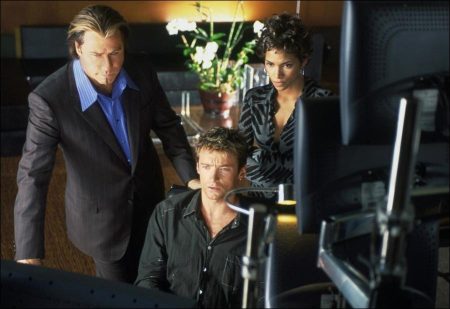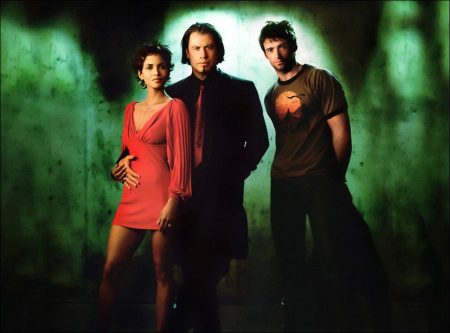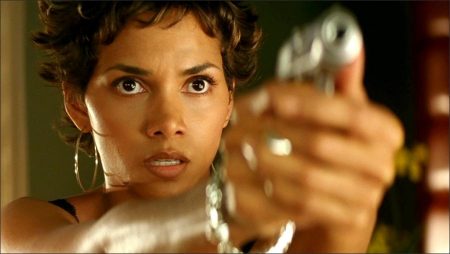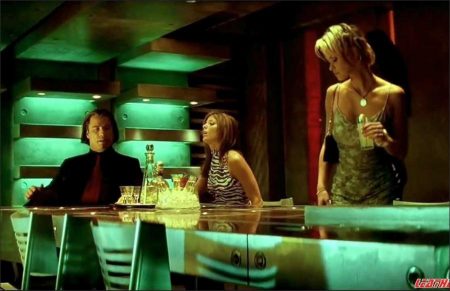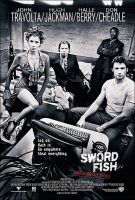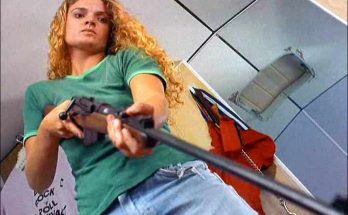Taglines: Once you know the password you can go anywhere.
Swordfish movie storyline. When the DEA shut down its dummy corporation operation codenamed Swordfish in 1986, they had generated $400 million which they let sit around; fifteen years of compound interest has swelled it to $9.5 billion. A covert counter-terrorist unit called Black Cell, headed by the duplicitious and suave Gabriel Shear, wants the money to help finance their raise-the-stakes vengeance war against international terrorism, but it’s all locked away behind super-encryption. He brings in convicted hacker Stanley Jobson, who only wants to see his daughter Holly again but can’t afford the legal fees, to slice into the government mainframes and get the money.
Swordfish is a 2001 American action crime thriller film directed by Dominic Sena and starring John Travolta, Hugh Jackman, Halle Berry, Don Cheadle and Vinnie Jones. The film centers on Stanley Jobson, an ex-con and computer hacker who is targeted for recruitment into a bank robbery conspiracy because of his formidable hacking skills. The film was a slight box office success but was negatively received by critics upon release.
The soundtrack for Swordfish was produced by Paul Oakenfold, under Village Roadshow and Warner Bros. and distributed through London Sire Records, Inc. It contains 15 tracks. The film’s orchestral score was written by Christopher Young with several electronic additions by Paul Oakenfold. Fragments from the score were added to the official soundtrack, but were remixed by Oakenfold. A more complete release was issued as an award promo, which is known for its rarity.
Film Review for Swordfish
No Hollywood action thriller has begun quite like ”Swordfish,” in which a cocky John Travolta, smirking at the camera, offers a jauntily erudite and cynical analysis of ”Dog Day Afternoon.” It is such a nervy (not to mention critic-massaging) opening gambit that for a tantalizing moment this high-tech spy yarn looks to be one of the brighter progeny of ”Pulp Fiction.”
As the camera slowly pulls away, it emerges that Mr. Travolta is portraying the cinematically savvy mastermind of a bank robbery and hostage drama of such massive proportions as to make the events of Sidney Lumet’s great 1975 film look like a piddling grade-school rehearsal. Retreating further, the camera reveals this robbery (of $90 billion from a Los Angeles bank) to be in progress.
The terrified bank employees held hostage have been turned into human land mines loaded with explosives and ball bearings that if detonated by remote control will wreak maximum destruction. And sure enough, in a panicky moment, one of them explodes and a car drops out of the sky amid acres of shattered glass. So much for the movie’s first violent spasm.
Much of the rest of ”Swordfish” is devoted to filling in the background of a situation that seems indecipherable in the opening scene. But unhappily, as the movie goes along, its initial flash of wit and its hint of an ironic self-referential sensibility quickly dim. ”Swordfish” turns into a meticulously choreographed bang-by-the-numbers action fantasy that I would accuse of peddling evil if the film weren’t so dumb and incoherent.
Watching ”Swordfish,” produced by Joel Silver (”The Matrix”) and Jonathan D. Krane (”Face/Off”) and directed by Dominic Sena (”Gone in 60 Seconds”), feels like observing an elaborate toy that when plugged in performs pyrotechnic visual feats at regular market-tested intervals. Each antic slightly tops the one before until the entire program culminates with one last ultragimmick.
In that final trick, a busload of hostages pursued by the police (here Mr. Travolta’s character throws in a lame reference to ”The Sugarland Express”) is lifted off the highway by helicopter and borne over the streets of Los Angeles. When one of the hooks attached to the aircraft loosens, the perilously dangling vehicle smashes through the top stories of several glass towers. This triple whammy seizure of destruction is almost worth waiting for.
The contraption comes with a morally repugnant scenario. Mr. Travolta’s character, Gabriel Shear, is a ruthless high-tech superspy who engages the foremost computer hackers to enter the world’s most impenetrable vaults of classified information and wealth. Gabriel isn’t just another greedy villain. His allegedly high-minded agenda is to protect ”American freedoms” by striking back at terrorism directed against the United States with a brutality so fearsome that terrorism will soon cease to exist. An ineptly developed and abruptly abandoned subplot puts him in cahoots with a scheming, power-mad senator (Sam Shepard).
To finance his global vigilantism, Gabriel sets his sights on an international bank holding government-confiscated drug money that has been earning interest for decades. Because it’s bad money stolen from bad people, he reasons, it isn’t bad theft. Even if his operation costs some innocent lives, he further reasons, they’re worth sacrificing for the greater goal of stamping out terrorism. Infinitely arrogant and as apparently indestructible as Superman, Gabriel likes to compare himself to Houdini.
Gabriel’s moral opponent and helpless pawn, Stanley Jobson (Hugh Jackman), is an embittered genius computer hacker recently released from prison who labors on an oil rig and lives in a trailer. Stanley wants only to reunite with the 10-year-old daughter he is legally forbidden to visit by his slatternly former wife, who married a wealthy pornography lord.
But before Stanley can earn the $10 million Gabriel offers him, he has to pass several tests. In one, he is given 60 seconds to hack into the Defense Department’s inner sanctum with a gun held to his head while a beautiful woman performs oral sex on him. This beat-the-clock set piece, tricked out with dazzling computerized bells and whistles, is one of the movie’s desperate attempts to transform the tedious task of computer hacking into a sexy activity. Mr. Jackman’s Stanley stirs up further excitement by dancing around like a mad cowboy to conjure up his brainstorms. Who knew that typing could be so intense?
The movie’s spurious moral dialogue pits Gabriel’s coldblooded end-justifies-the-means attitude toward human life with Stanley’s weepy protectiveness of his little girl who is worth more than all the gold in Fort Knox. With its blasé blend of bogus international intrigue and action-for-action’s-sake, ”Swordfish” suggests a James Bond movie stripped of humor. True, there are a few moments of wit, like the opening sequence. But the dominant tone masquerading as humor is a snide, rancid nihilism devoid of laughs, unless wholesale destruction and gloating stupidity are what tickle your funny bone.
The sex element is provided by Halle Berry as Ginger, Gabriel’s partner. (Or is she really a government agent?) Ms. Berry, who goes topless in one scene, is certainly fetching to look at, but her character makes absolutely no sense. Even given the undemanding dramatic standards of the genre, her performance is pallid and detached, her screen aura coldly one-dimensional.
The role of Gabriel is a piece of cake for Mr. Travolta. Returning to his jovially sinister mode, sporting a longish Eurotrash haircut and flashing mocking crocodile grins, he walks through the movie (or rather trudges through it, since this portly actor could lose a few pounds of flab) with an unruffled confidence.
As for Mr. Jackman, if a clone of the young Clint Eastwood were hybridized with the younger Mel Gibson, you would have an exact copy of this Australian actor, who exudes a trace more passion and vulnerability than either predecessor. Having previously starred in ”X-Men,” Mr. Jackman needs only one more hit for certification as a bankable action megastar. ”Swordfish” might very well do the trick.
Swordfish (2001)
Oirected by: Dominic Sena
Starring: John Travolta, Halle Berry, Hugh Jackman, Don Cheadle, Vinnie Jones, Sam Shepard, Drea de Matteo, Camryn Grimes, Angelo Pagan, Rudolf Martin
Screenplay by: Skip Woods
Production Design by: Jeff Mann
Cinematography by: Paul Cameron
Film Editing by: Stephen E. Rivkin
Costume Design byı: Ha Nguyen
Set Decoration by: Jay Hart
Art Direction by: Geoff Hubbard, Andrew Laws, Jeff Wallace
Music by: Paul Oakenfold, Christopher Young
MPAA Rating: R for violence, language and some sexuality / nudity.
Distributed by: Warner Bros. Pictures
Release Date: June 8, 2001
Views: 237
